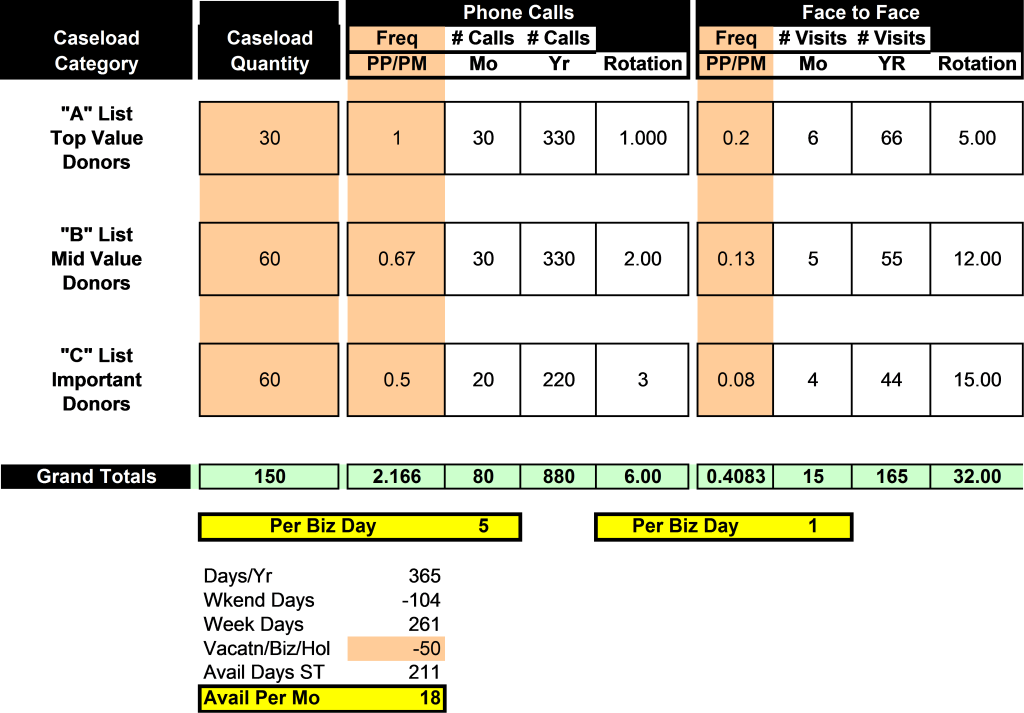OK, I know that the chart below will make your head spin, but here is what I want you to do. Take a look at it and note that there are only 150 qualified donors. 30 of those donors are “top value – A list” donors, and the remaining donors are split between “mid-value/B” donors and “important/C” donors.
Before you read any further, go to the bottom of the chart and note that there are very few actual days for an MGO to work on his caseload – just 18 days a month, on average.

Alright, I know I have a bunch of other numbers on this chart. Rather than getting muddled up with those numbers, all of which are instructive and helpful in managing your caseload properly, I want to tell you a story. It’s the case of the bloated caseload.
I have, once again, run into a situation where a manager of MGOs is fostering and nurturing a major gift concept in his organization that has an average of 465 major donors on each caseload of his MGOs. This is a mid-sized charity in the Midwest. When I asked the manager for his rationale for so many donors on one caseload he said, “Richard, I want our MGOs to first represent the organization in a specific geography. Then I want them to have enough donors so they can reach the million dollar per year goal I have set for each of them.”
Let’s break this bloated caseload situation down a bit using the manager’s own words:
- “I want our MGOs to represent the organization in a specific geography.” This statement does not have a focus on major gifts. Nope. Instead, it’s about doing PR, events, awareness activities and who knows what else in a specific geography. Crazy.
- “They need to have enough donors so they can reach the million dollar goal.” Hmmm. Do you see how this works? You set a million dollar goal, THEN keep adding donors until you can get the gross number up. And then, bingo, you have done a great thing. Not so fast. Dig a little deeper and you find that the average gift per donor is below $2,000 per year. This doesn’t sound like a major gift program to me. It sort of feels like someone is cooking the books. But I suppose, on one level, if you can get the gross number up, it feels like some important major gift work is happening. Sadly, just the opposite is happening.
This misguided state of affairs would be funny if it wasn’t so tragic. The manager is maintaining a system that assures that his MGOs will fail. First of all, they cannot possibly manage this many donors – it is physically impossible. And, secondly, adding non-major gift responsibilities to the job description makes it even more difficult.
Jeff and I have been consistently telling MGOs and managers to limit the size of the caseload to 150 qualified donors. By qualified we mean that the donor meets the major gift criteria of the organization AND has directly agreed to have a more personal relationship with the MGO. So, 150 qualified donors.
What is the rationale for this number? Well, turn your attention back to the chart.
- First, there are precious few days in each month for a major gift officer to work. By my calculations, it is somewhere in the vicinity of 18 days. Not very much time.
- There is so much to do with the 150 donors on the caseload – almost too much. Look at the “A” donors. I put 30 there. Let’s say you call each donor 1 time a month – could be a short call to tell her she made a difference, to update her on a topic you are focusing on, to talk about any number of things a person in relationship talks about. If you speak with each donor 1 time a month – that’s 30 calls right there. Then there are the 6 visits per month where you cycle through the 30 donors with one visit every 5 months. That frequency involves preparation and time. You are spending a TON of time on just this group of donors. Imagine just that point – how could you possibly have much time left? These are quality relationships. And if you look down the chart to the other activities that are called out, you can quickly discern that there is very little time to get it all done and have a quality relationship with the donor.
Now, you may disagree with the amount of calls or visits. So, go ahead and disagree. Put your own numbers in there. You will still come to the same conclusion. And it’s this: developing an average level of quality in an average relationship with a caseload donor takes a lot of time.
And it is this concept – the amount of time as it relates to quality relationships – that escapes many MGOs and their managers. It certainly escaped the manager of the bloated caseload.
My question for you is this: what is the size of your caseload? If it’s above 150, it’s way too high. So take steps to trim it down. It may feel counter-intuitive, but if you focus on fewer good donors and go deep with them, your result will be much better on several levels: relationally for the donor and for you, and economically for the organization.
Think about this. It really makes practical sense.
Richard




0 Comments